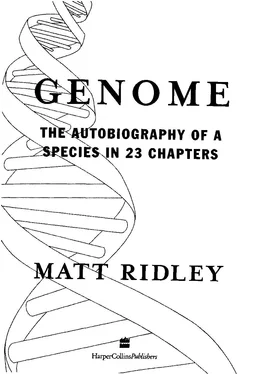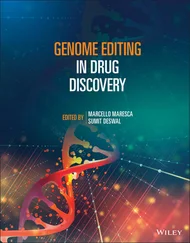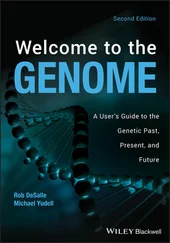Genome - Matt Ridley
Здесь есть возможность читать онлайн «Genome - Matt Ridley» — ознакомительный отрывок электронной книги совершенно бесплатно, а после прочтения отрывка купить полную версию. В некоторых случаях можно слушать аудио, скачать через торрент в формате fb2 и присутствует краткое содержание. Жанр: Старинная литература, на английском языке. Описание произведения, (предисловие) а так же отзывы посетителей доступны на портале библиотеки ЛибКат.
- Название:Matt Ridley
- Автор:
- Жанр:
- Год:неизвестен
- ISBN:нет данных
- Рейтинг книги:5 / 5. Голосов: 1
-
Избранное:Добавить в избранное
- Отзывы:
-
Ваша оценка:
- 100
- 1
- 2
- 3
- 4
- 5
Matt Ridley: краткое содержание, описание и аннотация
Предлагаем к чтению аннотацию, описание, краткое содержание или предисловие (зависит от того, что написал сам автор книги «Matt Ridley»). Если вы не нашли необходимую информацию о книге — напишите в комментариях, мы постараемся отыскать её.
Matt Ridley — читать онлайн ознакомительный отрывок
Ниже представлен текст книги, разбитый по страницам. Система сохранения места последней прочитанной страницы, позволяет с удобством читать онлайн бесплатно книгу «Matt Ridley», без необходимости каждый раз заново искать на чём Вы остановились. Поставьте закладку, и сможете в любой момент перейти на страницу, на которой закончили чтение.
Интервал:
Закладка:
This makes good evolutionary sense because unlike, say, skin cells, each neuron is an exquisitely shaped, trained and experienced opera-tor. To replace it with a naive and untrained randomly shaped neuron would be worse than useless. When a virus gets into a neuron, the neuron is not instructed to undergo apoptosis. Instead, for reasons that are not entirely clear, the virus itself sometimes induces apoptosis of the neuron. This is true in the case of fatal alphavirus encephalitis, for instance.10
Apoptosis can also be useful in preventing other kinds of mutiny than cancer, such as genetic distortion of the kind induced by selfish transposons. There is some good evidence that the germ cells in the ovary and testicle are under surveillance from follicular and Sertoli cells respectively, whose job is to detect any such selfishness and, if so, to induce apoptosis. In the ovary of a five-month-old human foetus, for example, there are nearly seven million germ cells.
By birth, there are only two million, and of those two million, just 400 or so will be ovulated during the coming lifetime. Most of the rest will be culled by apoptosis, which is ruthlessly eugenic, issuing strict orders to cells that are not perfect to commit suicide (the body is a totalitarian place).
The same principles may apply in the brain, where there is mass culling of cells during development by ced-9 and other genes. Again, 2 4 2 G E N O M E
any cell that does not work well is sacrificed for the good of the whole. So not only does the apoptotic cull of neurons enable learning to take place, it also improves the average quality of the cells that remain. Something similar probably happens in the immune cells, another subject to ruthless culling of cells by apoptosis.
Apoptosis is a decentralised business. There is no central planning, no bodily Politburo deciding who should die and who should live.
That is the beauty of it. Like the development of the embryo, it harnesses the self-knowledge of each cell. There is only one conceptual difficulty: how apoptosis could have evolved. In passing the test of killing itself if infected, cancerous or genetically mischievous, a cell by definition dies. It cannot therefore pass on its goodness to its daughters. Known as 'the kamikaze conundrum', this problem is solved by a form of group selection: whole bodies in which apoptosis works well do better than whole bodies in which it fails to work; the former therefore pass on the right traits to the cells of their offspring. But it does mean that the apoptotic system cannot improve during a person's lifetime, because it cannot evolve by natural selection within the body. We are stuck with the cell-suicide mechanism that we inherited.11
C H R O M O S O M E 1 8
C u r e s
Our doubts are traitors,
And make us lose the good we oft might win,
By fearing to attempt.
William Shakespeare, Measure for Measure As the third millennium dawns, we are for the first time in a position to edit the text of our genetic code. It is no longer a precious manuscript; it is on disc. We can cut bits out, add bits in, rearrange paragraphs or write over words. This chapter is about how we can do these things, whether we should, and why, on the brink of doing so, our courage seems to be failing us and we are strongly tempted to throw away the whole word processor and insist that the text remains sacrosanct. This chapter is about genetic manipulation.
For most laymen, the obvious destination towards which genetic research is headed, the ultimate prize if you like, is a genetically engineered human being. One day, centuries hence, that might mean a human being with newly invented genes. For the moment it means a human being with an existing gene borrowed from another human being, or from an animal or plant. Is such a thing possible? And, if it is possible, is it ethical?
2 4 4 G E N O M E
Consider a gene on chromosome 18 that suppresses colon cancer.
We have already met it briefly in the last chapter: a tumour suppressor whose location has not quite been determined for sure. It was thought to be a gene called DCC, but we now know that DCC
guides the growth of nerves in the spinal column and has nothing to do with tumour suppression. The tumour-suppressor gene is close to DCC, but it is still elusive. If you are born with an already faulty version of this gene you have a much increased risk of cancer. Could a future genetic engineer take it out, like a faulty spark plug from a car, and replace it? The answer, quite soon, will be yes.
I am just old enough to have begun my career in journalism cutting paper with real scissors and pasting with real glue. Nowadays, to move paragraphs around I use little software icons suitably decor-ated by the kind folk at Microsoft to indicate that they do the same job. (I have just moved this paragraph to here from the next page.) But the principle is the same: to move text, I cut it out and paste it back in somewhere else.
To do the same for the text of genes also requires scissors and glue. In both cases, fortunately nature had already invented them for her own purposes. The glue is an enzyme called ligase, which stitches together loose sentences of D N A whenever it comes across them. The scissors, called restriction enzymes, were discovered in bacteria in 1968. Their role in the bacterial cell is to defeat viruses by chopping up their genes. But it soon emerged that, unlike real scissors, a restriction enzyme is fussy: it only cuts a strand of D N A where it encounters a particular sequence of letters. We now know of 400 different kinds of restriction enzymes, each of which recognises a different sequence of D N A letters and cuts there, like a pair of scissors that cuts the paper only where it finds the word 'restriction'.
In 1972, Paul Berg of Stanford University used restriction enzymes in a test tube to chop two bits of viral D N A in half, then used ligases to stick them together again in new combinations. He thus produced the first man-made 'recombinant' D N A . Humanity could now do what retroviruses had long been doing: insert a gene into a C U R E S 245
chromosome. Within a year, the first genetically engineered bacterium existed: a gut bacterium infected with a gene taken out of a toad.
There was an immediate surge of public concern and it was not confined to lay people. Scientists themselves thought it right to pause before rushing to exploit the new technology. They called a moratorium on all genetic engineering in 1974, which only fanned the flames of public worry: if the scientists were worried enough to stop, then there really must be something to worry about. Nature placed bacterial genes in bacteria and toad genes in toads; who were we to swap them? Might the consequences not be terrible? A conference, held at Asilomar in 1975, thrashed out the safety arguments and led to a cautious resumption of genetic engineering in America under the supervision of a federal committee. Science was policing itself. The public anxiety seemed gradually to die down, though it was to revive quite suddenly in the mid-1990s, this time focusing not on safety but on ethics.
Biotechnology was born. First Genentech, then Cetus and Biogen, then other companies sprang up to exploit the new technique. A world of possibilities lay before the nascent businesses. Bacteria could now be induced to make human proteins for medicine, food or industrial use. Only gradually did disappointment dawn, when it emerged that bacteria were not very good at making most human proteins and that human proteins were too little known to be in great demand as medicines. Despite immense venture-capital investment, the only companies that made profits for their shareholders were the ones, such as Applied Biosystems, that made equipment for the others to use. Still, there were products. By the late 1980s, human growth hormone, made by bacteria, had replaced the expensive and dangerous equivalent extracted from the brains of cadavers.
Читать дальшеИнтервал:
Закладка:
Похожие книги на «Matt Ridley»
Представляем Вашему вниманию похожие книги на «Matt Ridley» списком для выбора. Мы отобрали схожую по названию и смыслу литературу в надежде предоставить читателям больше вариантов отыскать новые, интересные, ещё непрочитанные произведения.
Обсуждение, отзывы о книге «Matt Ridley» и просто собственные мнения читателей. Оставьте ваши комментарии, напишите, что Вы думаете о произведении, его смысле или главных героях. Укажите что конкретно понравилось, а что нет, и почему Вы так считаете.












